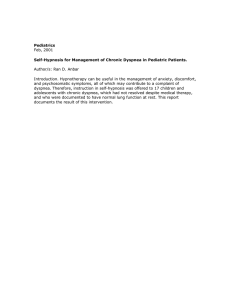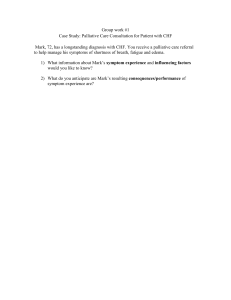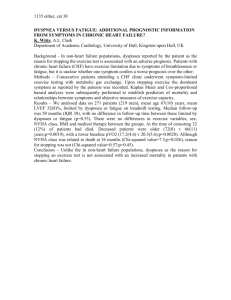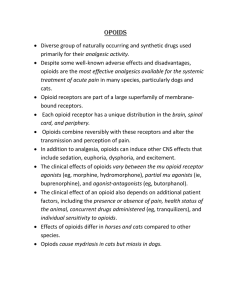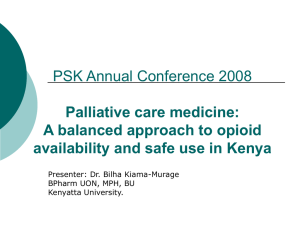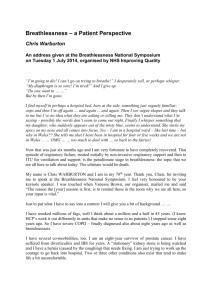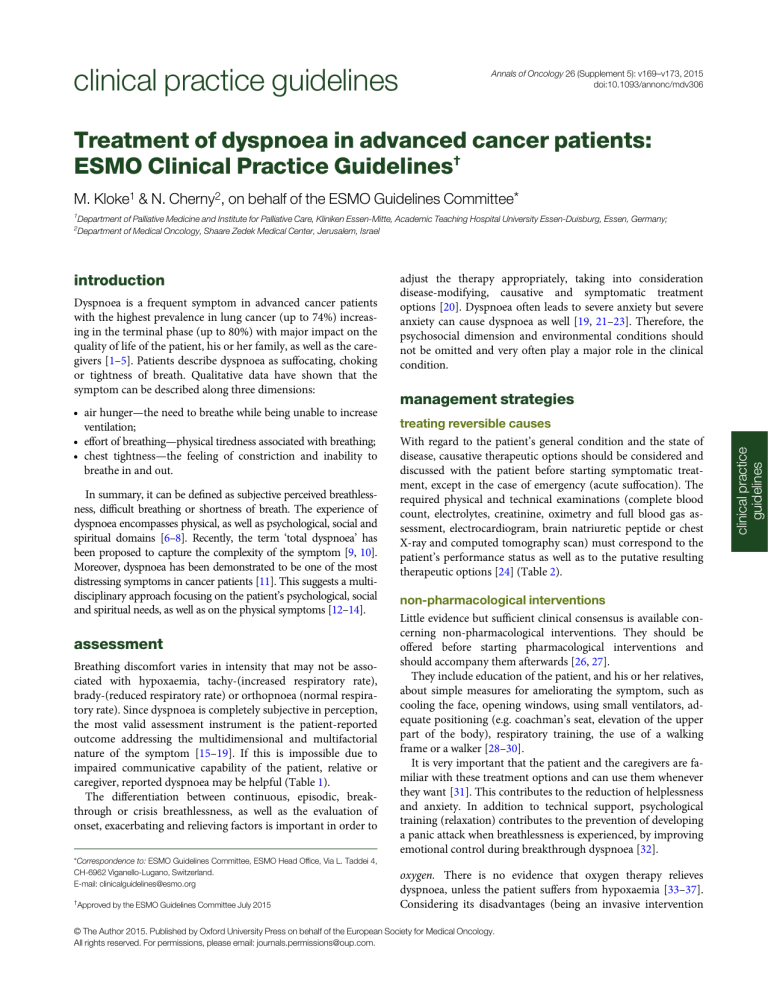
clinical practice guidelines Annals of Oncology 26 (Supplement 5): v169–v173, 2015 doi:10.1093/annonc/mdv306 Treatment of dyspnoea in advanced cancer patients: ESMO Clinical Practice Guidelines† M. Kloke1 & N. Cherny2, on behalf of the ESMO Guidelines Committee* 1 Department of Palliative Medicine and Institute for Palliative Care, Kliniken Essen-Mitte, Academic Teaching Hospital University Essen-Duisburg, Essen, Germany; Department of Medical Oncology, Shaare Zedek Medical Center, Jerusalem, Israel 2 Dyspnoea is a frequent symptom in advanced cancer patients with the highest prevalence in lung cancer (up to 74%) increasing in the terminal phase (up to 80%) with major impact on the quality of life of the patient, his or her family, as well as the caregivers [1–5]. Patients describe dyspnoea as suffocating, choking or tightness of breath. Qualitative data have shown that the symptom can be described along three dimensions: • air hunger—the need to breathe while being unable to increase ventilation; • effort of breathing—physical tiredness associated with breathing; • chest tightness—the feeling of constriction and inability to breathe in and out. In summary, it can be defined as subjective perceived breathlessness, difficult breathing or shortness of breath. The experience of dyspnoea encompasses physical, as well as psychological, social and spiritual domains [6–8]. Recently, the term ‘total dyspnoea’ has been proposed to capture the complexity of the symptom [9, 10]. Moreover, dyspnoea has been demonstrated to be one of the most distressing symptoms in cancer patients [11]. This suggests a multidisciplinary approach focusing on the patient’s psychological, social and spiritual needs, as well as on the physical symptoms [12–14]. assessment Breathing discomfort varies in intensity that may not be associated with hypoxaemia, tachy-(increased respiratory rate), brady-(reduced respiratory rate) or orthopnoea (normal respiratory rate). Since dyspnoea is completely subjective in perception, the most valid assessment instrument is the patient-reported outcome addressing the multidimensional and multifactorial nature of the symptom [15–19]. If this is impossible due to impaired communicative capability of the patient, relative or caregiver, reported dyspnoea may be helpful (Table 1). The differentiation between continuous, episodic, breakthrough or crisis breathlessness, as well as the evaluation of onset, exacerbating and relieving factors is important in order to *Correspondence to: ESMO Guidelines Committee, ESMO Head Office, Via L. Taddei 4, CH-6962 Viganello-Lugano, Switzerland. E-mail: clinicalguidelines@esmo.org † Approved by the ESMO Guidelines Committee July 2015 adjust the therapy appropriately, taking into consideration disease-modifying, causative and symptomatic treatment options [20]. Dyspnoea often leads to severe anxiety but severe anxiety can cause dyspnoea as well [19, 21–23]. Therefore, the psychosocial dimension and environmental conditions should not be omitted and very often play a major role in the clinical condition. management strategies treating reversible causes With regard to the patient’s general condition and the state of disease, causative therapeutic options should be considered and discussed with the patient before starting symptomatic treatment, except in the case of emergency (acute suffocation). The required physical and technical examinations (complete blood count, electrolytes, creatinine, oximetry and full blood gas assessment, electrocardiogram, brain natriuretic peptide or chest X-ray and computed tomography scan) must correspond to the patient’s performance status as well as to the putative resulting therapeutic options [24] (Table 2). non-pharmacological interventions Little evidence but sufficient clinical consensus is available concerning non-pharmacological interventions. They should be offered before starting pharmacological interventions and should accompany them afterwards [26, 27]. They include education of the patient, and his or her relatives, about simple measures for ameliorating the symptom, such as cooling the face, opening windows, using small ventilators, adequate positioning (e.g. coachman’s seat, elevation of the upper part of the body), respiratory training, the use of a walking frame or a walker [28–30]. It is very important that the patient and the caregivers are familiar with these treatment options and can use them whenever they want [31]. This contributes to the reduction of helplessness and anxiety. In addition to technical support, psychological training (relaxation) contributes to the prevention of developing a panic attack when breathlessness is experienced, by improving emotional control during breakthrough dyspnoea [32]. oxygen. There is no evidence that oxygen therapy relieves dyspnoea, unless the patient suffers from hypoxaemia [33–37]. Considering its disadvantages (being an invasive intervention © The Author 2015. Published by Oxford University Press on behalf of the European Society for Medical Oncology. All rights reserved. For permissions, please email: journals.permissions@oup.com. clinical practice guidelines introduction clinical practice guidelines Annals of Oncology Table 1. Dimensions of dyspnoea Dimension Criterion Measurement Sensory-perceptual experience Intensity NRS, VAS Affective distress Emotional unpleasantness NRS, VAS, HADS Impact on daily life Meaning for social contact, functioning, quality of life CRQ, EORTC-QLQ-C15-PAL, MRC, SF12 NRS, Numerical Rating Scale; VAS, visual Analogue Scale; MRC, Medical Research Council; CRQ, Chronic Respiratory Disease Questionnaire; HADS, Hospital Depression and Anxiety scale®; SF12 Health survey®; EORTC-QLQ-C15-PAL questionnaire to assess the quality of life of palliative cancer care patients. Table 2. Pathophysiology and causative intervention (examples only) [25] Pathophysiology Targeted intervention Pleural effusion Pleural drainage, pleurodesis Cancer-induced airways obstruction Endoscopic or surgical intervention (stent, laser, argon-beamer) Localised radiotherapy Anaemia Transfusions Erythropoietin administration for chemotherapy-induced anaemia Infections, e.g. pneumonia Antibiotics, antifungal drugs Airway obstruction and chronic obstructive pulmonary disease as comorbidity Airway dilatators, corticosteroids Haemoptysis Antifibrinolytics, endoscopic or surgical intervention (stent, laser, argon-beamer), irradiation Pulmonary congestion Diuretics or other appropriate intervention Pericardial effusion Pericardial puncture, pericardiodesis Upper venous congestion Corticosteroids, irradiation, stenting of the vena cava, anticoagulation Chest pain Optimised analgesia requiring tubing and tanks), its risk of nosebleeds from the nasal cannula, and the patient’s psychological addiction to this ‘umbilical cord’, it cannot be recommended for routine use. Even in the home-care setting, it serves as a surrogate for caregivers who may feel helpless and distressed when watching a breathless family member at home. Oxygen could be used for a short period before physical efforts or eating. Oxygen supplementation through ventouri masks can offer significant alleviation of dyspnoea in patients with hypoxaemia, if the patient suffered from chronic obstructive pulmonary disease as a co-morbidity and has been on oxygen before. pharmacological treatment opioids. Opioids are the only pharmacological agents with sufficient evidence in the palliation of dyspnoea [38–41]. They can be used in opioid-naive as well as in opioid-tolerant patients without causing relevant breath depression or impaired oxygenation or increase in CO2 concentration [42]. Nevertheless, patients receiving opioids for breathlessness experience the well-known opioid-related unwanted side effects, e.g. initial nausea and persistent constipation. The mechanism of the antidyspnoeic effect of opioids seems complex and is mediated via opioid receptors of the cardio-respiratory system as well as different areas in the central nervous system [43–49]. There is v | Kloke et al. some evidence for a close relationship between dyspnoea and anxiety. Opioids reduce the unpleasantness of dyspnoea. Although evidence has been provided only for oral and parenteral morphine, diamorphine and dihydrocodeine, larger series, retrospective studies and case reports suggest that no opioid is superior to another and that hydromorphone, fentanyl and oxycodone may also be used [46, 50–52]. Morphine should be avoided in patients with severe renal insufficiency, while dosage and dosage intervals should be adapted to the renal function for all µ-opioids because of their renal elimination [53–55]. Normal-release preparations of oral/rectal opioids may be used for titration, switching to sustained preparation afterwards [56]. Subcutaneously and intravenously applied opioids are effective, with the intravenous form having the most rapid onset. There is no evidence for the efficacy of nebulised or inhaled opioids [18, 57, 58]. The importance of buccal, nasal or transdermal preparations still remains unclear. In opioid-naïve patients, the starting dose for dyspnoea is smaller than that for pain palliation [59]. On the contrary, patients receiving opioids for analgesia require an increase of dosage up to 25% or 50% [60] ( Table 3). benzodiazepines. Benzodiazepines can be used in cases of nonor insufficient response to opioids, either alone or in addition to Volume 26 | Supplement 5 | September 2015 clinical practice guidelines Annals of Oncology Opioid Starting dose opioid naive Starting dose in concomitant opioid intake hydration, adding antisecretory drugs such as atropine, hyoscine or glycopyrronium bromide and optimise positioning of the dying. Morphine 2.5–5 mg/4 h p.o. 1–2.5 mg/4 h s.c. Regular opioid dose + 1/6 of the daily opioid intake methodology Hydromorphone 1.3 mg/4 h p.o. 0.2–0.5 mg/4 h s.c. Regular opioid dose + 1/6 of the daily opioid intake Table 3. Starting doses of opioids for the palliation of dyspnoea Benzodiazepine Dosage Lorazepam 0.5–1.0 mg/6–8 h p.o. or s.l. These clinical practice guidelines were developed in accordance with the ESMO standard operating procedures for clinical practice guidelines development. They are based on the international literature and the available scientific guidelines and the relevant literature has been selected by the expert authors. Because these recommendations are not based on a systematic review of the evidence, undertaken by guideline development group members, with support from the SIGN Executive, they are not graded. For this purpose, we refer to the scientific German S3 guidelines. However, this manuscript has been subjected to an anonymous peer review process. Midazolam 2.5–5 mg/4 h s.c. 10–30 mg/24 h s.c. acknowledgements p.o., oral; s.c., subcutaneous. Table 4. Recommended dosages of benzodiazepines for the palliation of dyspnoea s.c., subcutaneous; s.l., sublingual; p.o. oral. opioids, especially in patients experiencing anxiety [61–65]. They predominantly reduce the unpleasantness of dyspnoea and also act as anxiolytics. Therefore, their use can be recommended, especially in the far advanced stages and in the dying patient. Lorazepam and midazolam seem to be the most commonly used substances. Nevertheless, the impact of muscle relaxation and its potential contribution to the intensification of dyspnoea, especially in cancer cachexia and sarcopenia, should be taken into consideration (Table 4). other drugs. ‘Neuroleptics’ such as phenothiazines act as anxiolytics and sedatives. This led to the assumption that they may be helpful in treating dyspnoea. To date, proven evidence is lacking and therefore they cannot be recommended [66–68]. ‘Antidepressants and buspirone’ are reputed to exert some antidyspnoeic efficacy as mood-enhancing medication; nevertheless, this has not yet been proven [69–78]. ‘Steroids’ proved to be effective in dyspnoea caused by lymphangiosis carcinomatosa, radiation pneumonitis, superior vena cava syndrome, an inflammatory component, or in (cancerinduced) obstruction of the airways [79–83]. They should not be used routinely other than for these indications [1, 84–86]. dyspnoea in the dying patient Dyspnoea is a frequent and perhaps one of the most distressing symptoms in the last days of life [87]. The basis of coping with this suffering is the same as that described within the palliative context. Nevertheless, the focus of treatment shifts to pharmacological treatment (including terminal sedation with benzodiazepine in addition to opioids) if treatment is insufficient [88– 92]. Human attendance and empathy are paramount. Death rattle sometimes aggravates the burden of relatives. Therefore, the clarification of its nature is paramount for them. Pharmacological interventions include reduction of artificial Volume 26 | Supplement 5 | September 2015 These clinical recommendations refer to the German scientific stage 3 guideline ‘Palliative Care’, part of the guideline initiative covering the whole area of oncology. The guideline ‘Palliative Care’ has been masterminded by members of the German Society for Palliative Care, the German Cancer Society and the German Cancer Aid in collaboration with many other scientific societies. It has been promoted by the Association of the Scientific Medical Societies in Germany (AWMF) and published in May 2015 (http://www.awmf.org/uploads/tx_szleitlinien/128001OLl_S3_Palliativmedizin_2015-04.pdf ). conflict of interest MK has been investigator of the Effendys Study sponsored by TEVA Pharmaceutical Industries and is member of the advisory board of this company. NC has declared no potential conflicts of interest. references 1. Altfelder N, Nauck F, Alt-Epping B et al. Characteristics of patients with breathlessness—a German national survey on palliative care in-patient units. Palliat Med 2010; 24: S37 (abstract). 2. Bausewein C, Booth S, Gysels M et al. Individual breathlessness trajectories do not match summary trajectories in advanced cancer and chronic obstructive pulmonary disease: results from a longitudinal study. Palliat Med 2010; 24: 777–786. 3. Goeckenjan G, Sitter H, Thomas M et al. [Prevention, diagnosis, therapy, and follow-up of lung cancer]. Pneumologie 2010; 64(Suppl 2): e1–e164 [Article in German]. 4. Gysels MH, Higginson IJ. Caring for a person in advanced illness and suffering from breathlessness at home: threats and resources. Palliat Support Care 2009; 7: 153–162. 5. Walsh D, Donnelly S, Rybicki L. The symptoms of advanced cancer: relationship to age, gender, and performance status in 1,000 patients. Support Care Cancer 2000; 8: 175–179. 6. American Thoracic Society. Dyspnea-mechanisms, assessment, and management: a consensus statement. Am J Respir Crit Care Med 1999; 159: 321–340. 7. Henoch I, Bergman B, Danielson E. Dyspnea experience and management strategies in patients with lung cancer. Psychooncology 2008; 17: 709–715. doi:10.1093/annonc/mdv306 | v clinical practice guidelines 8. Parshall MB, Schwartzstein RM, Adams L et al. An official American Thoracic Society statement: update on the mechanisms, assessment, and management of dyspnea. Am J Respir Crit Care Med 2012; 185: 435–452. 9. Abernethy AP, Wheeler JL. Total dyspnoea. Curr Opin Support Palliat Care 2008; 2: 110–113. 10. von Leupoldt A, Balewski S, Petersen S et al. Verbal descriptors of dyspnea in patients with COPD at different intensity levels of dyspnea. Chest 2007; 132: 141–147. 11. Tishelman C, Degner LF, Rudman A et al. Symptoms in patients with lung carcinoma: distinguishing distress from intensity. Cancer 2005; 104: 2013–2021. 12. Bausewein C, Jolley C, Reilly C. Development, effectiveness and cost-effectiveness of a new out-patient Breathlessness Support Service: study protocol of a phase III fast-track randomised controlled trial. BMC Pulm Med 2012; 12: 58. 13. Booth S, Moffat C, Farquhar M et al. Developing a breathlessness intervention service for patients with palliative and supportive care needs, irrespective of diagnosis. J Palliat Care 2011; 27: 28–36. 14. Farquhar MC, Prevost AT, McCrone P et al. Study protocol: phase III single-blinded fast-track pragmatic randomised controlled trial of a complex intervention for breathlessness in advanced disease. Trials 2011; 12: 130. 15. Bausewein C, Farquhar M, Booth S et al. Measurement of breathlessness in advanced disease: a systematic review. Respir Med 2007; 101: 399–410. 16. Bausewein C, Booth S., Higginson IJ. Measurement of dyspnoea in the clinical rather than the research setting. Curr Opin Support Palliat Care 2008; 2: 95–99. 17. Dorman S, Byrne A, Edwards A. Which measurement scales should we use to measure breathlessness in palliative care? A systematic review. Palliat Med 2007; 21: 177–191. 18. Grimbert D, Lubin O, de Monte M et al. [Dyspnea and morphine aerosols in the palliative care of lung cancer]. Rev Mal Respir 2004; 21: 1091–1097 [Article in French]. 19. Simon ST, Higginson IJ, Benalia H et al. Episodic and continuous breathlessness: a new categorization of breathlessness. J Pain Symptom Manage 2013; 45: 1019–1029. 20. Reddy SK, Parsons HA, Elsayem A et al. Characteristics and correlates of dyspnea in patients with advanced cancer. J Palliat Med 2009; 12: 29–36. 21. Bailey PH. The dyspnea-anxiety-dyspnea cycle—COPD patients’ stories of breathlessness: "It’s scary/when you can’t breathe". Qual Health Res 2004; 14: 760–778. 22. Davis CL. ABC of palliative care. Breathlessness, cough, and other respiratory problems. BMJ 1997; 315: 931–934. 23. Zabora J, BrintzenhofeSzoc K, Curbow B et al. The prevalence of psychological distress by cancer site. Psychooncology 2001; 10: 19–28. 24. Sakurada T, Kakiuchi S, Tajima S et al. Characteristics of and risk factors for interstitial lung disease induced by chemotherapy for lung cancer. Ann Pharmacother 2015; 49: 398–404. 25. Ost DE, Ernst A, Grosu HB et al. Therapeutic bronchoscopy for malignant central airway obstruction: success rates and impact on dyspnea and quality of life. Chest 2015; 147: 1282–1298. 26. Bausewein C, Booth S, Gysels M, Higginson I. Non-pharmacological interventions for breathlessness in advanced stages of malignant and non-malignant diseases. Cochrane Database Syst Rev 2008: CD005623. 27. Simon ST, Müller-Busch C, Bausewein C. [Symptom management of pain and breathlessness]. Internist (Berl) 2011; 52: 28, 30–35 [Article in German]. 28. Bausewein C, Booth S, Gysels M et al. Effectiveness of a hand-held fan for breathlessness: a randomised phase II trial. BMC Palliat Care 2010; 9: 22. 29. Galbraith S, Fagan P, Perkins P et al. Does the use of a handheld fan improve chronic dyspnea? A randomized, controlled, crossover trial. J Pain Symptom Manage 2010; 39: 831–838. 30. Probst VS, Troosters T, Coosemans I et al. Mechanisms of improvement in exercise capacity using a rollator in patients with COPD. Chest 2004; 126: 1102–1107. 31. Booth S, Silvester S, Todd C. Breathlessness in cancer and chronic obstructive pulmonary disease: using a qualitative approach to describe the experience of patients and carers. Palliat Support Care 2003; 1: 337–344. 32. Booth S, Moosavi SH, Higginson IJ. The etiology and management of intractable breathlessness in patients with advanced cancer: a systematic review of pharmacological therapy. Nat Clin Pract Oncol 2008; 5: 90–100. v | Kloke et al. Annals of Oncology 33. Abernethy AP, McDonald CF, Frith PA et al. Effect of palliative oxygen versus room air in relief of breathlessness in patients with refractory dyspnoea: a double-blind, randomised controlled trial. Lancet 2010; 376: 784–793. 34. Cranston JM, Crockett A, Currow D. Oxygen therapy for dyspnoea in adults. Cochrane Database Syst Rev 2008: CD004769. 35. Magnussen H, Kirsten AM, Köhler D et al. [Guidelines for long-term oxygen therapy. German Society for Pneumology and Respiratory Medicine]. Pneumologie 2008; 62: 748–756 [Article in German]. 36. Uronis H, McCrory DC, Samsa G et al. Symptomatic oxygen for non-hypoxaemic chronic obstructive pulmonary disease. Cochrane Database Syst Rev 2011; 15: CD006429. 37. Vogelmeier C, Buhl R, Criée CP et al. [Guidelines for the diagnosis and therapy of COPD issued by Deutsche Atemwegsliga and Deutsche Gesellschaft fur Pneumologie und Beatmungsmedizin]. Pneumologie 2007; 61: e1–e40 [Article in German]. 38. Clemens KE, Klaschik E. Symptomatic therapy of dyspnea with strong opioids and its effect on ventilation in palliative care patients. J Pain Symptom Manage 2007; 33: 473–481. 39. Currow DC, McDonald C, Oaten S et al. Once-daily opioids for chronic dyspnea: a dose increment and pharmacovigilance study. J Pain Symptom Manage 2011; 42: 388–399. 40. Johnson MJ, Hui D, Currow DC. Opioids, exertion, and dyspnea: a review of the evidence. Am J Hosp Palliat Care 2014 [Epub ahead of print]. 41. Oxberry SG, Torgerson DJ, Bland JM. Short-term opioids for breathlessness in stable chronic heart failure: a randomized controlled trial. Eur J Heart Fail 2011; 13: 1006–1012. 42. Caraceni A, Hanks G, Kaasa S et al. Use of opioid analgesics in the treatment of cancer pain: evidence-based recommendations from the EAPC. Lancet Oncol 2012; 13: e58–e68. 43. Johnson MJ, Abernethy AP, Currow DC. Gaps in the evidence base of opioids for refractory breathlessness. A future work plan? J Pain Symptom Manage 2012; 43: 614–624. 44. Pattinson KT, Governo RJ, MacIntosh BJ et al. Opioids depress cortical centers responsible for the volitional control of respiration. J Neurosci 2009; 29: 8177–8186. 45. Perna GP, Modoni S, Valle G et al. Plasma beta-endorphin response to exercise in patients with congestive heart failure. Chest 1997; 111: 19–22. 46. Simon ST, Köskeroglu P, Gaertner J, Voltz R. Fentanyl for the relief of refractory breathlessness—a systematic review. J Pain Symptom Manage 2013; 46: 874–886. 47. von Leupoldt A, Sommer T, Kegat S et al. The unpleasantness of perceived dyspnea is processed in the anterior insula and amygdala. Am J Respir Crit Care Med 2008; 177: 1026–1032. 48. von Leupoldt A, Sommer T, Kegat S et al. Dyspnea and pain share emotion-related brain network. Neuroimage 2009; 48: 200–206. 49. von Leupoldt A, Sommer T, Kegat S et al. Down-regulation of insular cortex responses to dyspnea and pain in asthma. Am J Respir Crit Care Med 2009; 180: 232–238. 50. Clemens KE, Klaschik E. Effect of hydromorphone on ventilation in palliative care patients with dyspnea. Support Care Cancer 2008; 16: 93–99. 51. Pang GS, Qu LM, Tan YY, Yee AC. Intravenous fentanyl for dyspnea at the end of life: lessons for future research in dyspnea. Am J Hosp Palliat Care 2014; [Epub ahead of print]. 52. Woodcock AA, Gross ER, Gellert A et al. Effects of dihydrocodeine, alcohol, and caffeine on breathlessness and exercise tolerance in patients with chronic obstructive lung disease and normal blood gases. N Engl J Med 1981; 305: 1611–1616. 53. King S, Forbes K, Hanks GW et al. A systematic review of the use of opioid medication for those with moderate to severe cancer pain and renal impairment: a European Palliative Care Research Collaborative opioid guidelines project. Palliat Med 2011; 25: 525–552. 54. Murtagh FE, Chai MO, Donohoe P et al. The use of opioid analgesia in end-stage renal disease patients managed without dialysis: recommendations for practice. J Pain Palliat Care Pharmacother 2007; 21: 5–16. 55. Twycross R, Wilcock A. Palliative Care Formulary, 4th edition. Nottingham: Palliativedrugs.com Ltd, 2011. Volume 26 | Supplement 5 | September 2015 Annals of Oncology 56. Abernethy AP, Currow DC, Frith P et al. Randomised, double blind, placebo controlled crossover trial of sustained release morphine for the management of refractory dyspnoea. BMJ 2003; 327: 523–528. 57. Bruera E, Sala R, Spruyt O et al. Nebulized versus subcutaneous morphine for patients with cancer dyspnea: a preliminary study. J Pain Symptom Manage 2005; 29: 613–618. 58. Charles MA, Reymond L, Israel F. Relief of incident dyspnea in palliative cancer patients: a pilot, randomized, controlled trial comparing nebulized hydromorphone, systemic hydromorphone, and nebulized saline. J Pain Symptom Manage 2008; 36: 29–38. 59. Clemens KE, Quednau I, Klaschik E. Is there a higher risk of respiratory depression in opioid-naive palliative care patients during symptomatic therapy of dyspnea with strong opioids? J Palliat Med 2008; 11: 204–216. 60. Allard P, Lamontagne C, Bernard P, Tremblay C. How effective are supplementary doses of opioids for dyspnea in terminally ill cancer patients? A randomized continuous sequential clinical trial. J Pain Symptom Manage 1999; 17: 256–265. 61. Navigante AH, Cerchietti LC, Castro MA et al. Midazolam as adjunct therapy to morphine in the alleviation of severe dyspnea perception in patients with advanced cancer. J Pain Symptom Manage 2006; 31: 38–47. 62. Navigante AH, Castro MA, Cerchietti LC. Morphine versus midazolam as upfront therapy to control dyspnea perception in cancer patients while its underlying cause is sought or treated. J Pain Symptom Manage 2010; 39: 820–830. 63. Simon ST, Higginson IJ, Booth S et al. Benzodiazepines for the relief of breathlessness in advanced malignant and non-malignant diseases in adults. Cochrane Database Syst Rev 2010: CD007354. 64. Smoller JW, Pollack MH, Otto MW et al. Panic anxiety, dyspnea, and respiratory disease. Theoretical and clinical considerations. Am J Respir Crit Care Med 1996; 154: 6–17. 65. Stege G, Heijdra YF, van den Elshout FJ et al. Temazepam 10 mg does not affect breathing and gas exchange in patients with severe normocapnic COPD. Respir Med 2010; 104: 518–524. 66. O’Neill PA, Morton PB, Stark RD. Chlorpromazine—a specific effect on breathlessness? Br J Clin Pharmacol 1985; 19: 793–797. 67. Rice KL, Kronenberg RS, Hedemark LL, Niewoehner DE. Effects of chronic administration of codeine and promethazine on breathlessness and exercise tolerance in patients with chronic airflow obstruction. Br J Dis Chest 1987; 81: 287–292. 68. Stark RD, Gambles SA, Lewis JA. Methods to assess breathlessness in healthy subjects: a critical evaluation and application to analyse the acute effects of diazepam and promethazine on breathlessness induced by exercise or by exposure to raised levels of carbon dioxide. Clin Sci 1981; 61: 429–439. 69. Argyropoulou P, Patakas D, Koukou A et al. Buspirone effect on breathlessness and exercise performance in patients with chronic obstructive pulmonary disease. Respiration 1993; 60: 216–220. 70. Bushunow PW, Roscoe JA, Dudgeon DJ et al. Buspirone treatment of dyspnea in outpatients receiving chemotherapy. A University of Rochester Cancer Center Community Clinical Oncology Program (URCC CCOP) study. J Clin Oncol 29: 2011 (suppl; abstr 9023). 71. Borson S, McDonald GJ, Gayle T et al. Improvement in mood, physical symptoms, and function with nortriptyline for depression in patients with chronic obstructive pulmonary disease. Psychosomatics 1992; 33: 190–201. 72. Eiser N, Harte R, Spiros K et al. Effect of treating depression on quality-of-life and exercise tolerance in severe COPD. COPD 2005; 2: 233–241. Volume 26 | Supplement 5 | September 2015 clinical practice guidelines 73. Fritzsche A, Clamor A, von Leupoldt A. Effects of medical and psychological treatment of depression in patients with COPD—a review. Respir Med 2011; 105: 1422–1433. 74. Lacasse Y, Beaudoin L, Rousseau L, Maltais F. Randomized trial of paroxetine in end-stage COPD. Monaldi Arch Chest Dis 2004; 61: 140–147. 75. Marciniuk DD, Goodridge D, Hernandez P et al. Managing dyspnea in patients with advanced chronic obstructive pulmonary disease: a Canadian Thoracic Society clinical practice guideline. Can Respir J 2011; 18: 69–78. 76. Singh NP, Despars JA, Stansbury DW et al. Effects of buspirone on anxiety levels and exercise tolerance in patients with chronic airflow obstruction and mild anxiety. Chest 1993; 103: 800–804. 77. Ström K, Boman G, Pehrsson K et al. Effect of protriptyline, 10 mg daily, on chronic hypoxaemia in chronic obstructive pulmonary disease. Eur Respir J 1995; 8: 425–429. 78. von Leupoldt A, Taube K, Lehmann K et al. The impact of anxiety and depression on outcomes of pulmonary rehabilitation in patients with COPD. Chest 2011; 140: 730–736. 79. du Bois RM, Greenhalgh PM, Southcott AM et al. Randomized trial of inhaled fluticasone propionate in chronic stable pulmonary sarcoidosis: a pilot study. Eur Respir J 1999; 13: 1345–1350. 80. Vestbo J, Pauwels R, Anderson JA et al. Early onset of effect of salmeterol and fluticasone propionate in chronic obstructive pulmonary disease. Thorax 2005; 60: 301–304. 81. Walters JA, Gibson PG, Wood-Baker R et al. Systemic corticosteroids for acute exacerbations of chronic obstructive pulmonary disease. Cochrane Database Syst Rev 2009: CD001288. 82. Yang IA, Fong KM, Sim EH et al. Inhaled corticosteroids for stable chronic obstructive pulmonary disease. Cochrane Database Syst Rev 2007; CD002991. 83. Zhang H, Liu C, Ji Z et al. Prednisone adding to usual care treatment for refractory decompensated congestive heart failure. Int Heart J 2008; 49: 587–595. 84. Aaron SD, Vandemheen KL, Hebert P et al. Outpatient oral prednisone after emergency treatment of chronic obstructive pulmonary disease. N Engl J Med 2003; 348: 2618–2625. 85. Milman N, Graudal N, Grode G, Munch E. No effect of high-dose inhaled steroids in pulmonary sarcoidosis: a double-blind, placebo-controlled study. J Intern Med 1994; 236: 285–290. 86. Tashkin DP, Rennard SI, Martin P et al. Efficacy and safety of budesonide and formoterol in one pressurized metered-dose inhaler in patients with moderate to very severe chronic obstructive pulmonary disease: results of a 6-month randomized clinical trial. Drugs 2008; 68: 1975–2000. 87. Heyse-Moore LH, Ross V, Mullee MA. How much of a problem is dyspnoea in advanced cancer? Palliat Med 1991; 5: 20–26. 88. Hu WY, Chiu TY, Cheng SY, Chen CY. Morphine for dyspnea control in terminal cancer patients: is it appropriate in Taiwan? J Pain Symptom Manage 2004; 28: 356–363. 89. Jennings AL, Davies AN, Higgins JP, Broadley K. Opioids for the palliation of breathlessness in terminal illness. Cochrane Database Syst Rev 2001: CD002066. 90. Reuben DB, Mor V. Dyspnea in terminally ill cancer patients. Chest 1986; 89: 234–236. 91. Skaug K, Eide GE, Gulsvik A. Prevalence and predictors of symptoms in the terminal stage of lung cancer: a community study. Chest 2007; 131: 389–394. 92. Conill C, Verger E, Henríquez I et al. Symptom prevalence in the last week of life. J Pain Symptom Manage 1997; 14: 328–331. doi:10.1093/annonc/mdv306 | v
